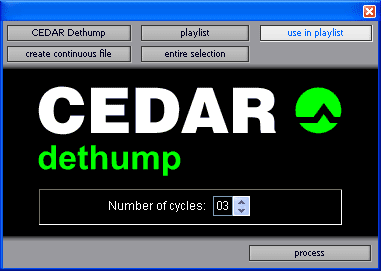CT17: Dethump
Eliminating thumps of up to 100,000 samples duration

The Problem
Thumps may last for many hundreds of milliseconds, so conventional declicking processes are unsuitable for restoring audio containing them. Furthermore, the spectral content of thumps will usually overlap the genuine signal, so simple filters cannot remove them without degrading the underlying signal.
The solution
Dethump eliminates the low frequency disturbances that cannot be restored using a declick process. It allows the user to identify the audio that constitutes the thump and uses the data in and around this to build up a picture of what the low frequency audio should have been had the thump not occurred. The process then replaces the thump with restored low frequency audio, leaving the undamaged high frequency data unaffected. This makes dethump the world's best tool for removing many of the previously intractible problems associated with optical soundtracks, as well as for restoring damaged cylinders and discs, and for cleaning modern recordings when, for example, microphones and stands are bumped.
The maximum thump length handled is enormous: 50,000 samples (a little over one second) at 44.1kHz, or 100,000 samples at 96kHz.
Now discontinued
Auto Dehiss
Declip
Retouch
Declick
Decrackle
Dethump
Return to the CEDAR Tools overview